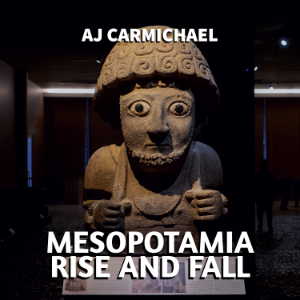

Mesopotamia, Rise and Fall
AJ CARMICHAEL
This audiobook is narrated by a digital voice.
The most famous legacies of Mesopotamia are its human-headed, winged bulls and wedge-shaped writing system. Even though these objects offer a glimpse into an ancient culture's grandeur and mystery, the region's influence extends far beyond them. One of the first civilizations in the world, Mesopotamia is often called the "cradle of civilization." The civilization contributed to the development of written language, economics, law, and religion. The pages of this book discuss many of these contributions. In Mesopotamia, for example, the lunar calendar was divided into two seasons, and the year was divided into 12 months. There were seven days in a week in the Sumerian calendar. Sexagesimal, or base 60, mathematics survives to this day based on 60-minute hours and 24-hour days in Mesopotamia.
The term Mesopotamia is typically used by historians to refer to the region in southwest Asia that includes modern-day Iraq and parts of Turkey, Iran, and Syria. Hellenistic Greeks used Mesopotamos to refer to the area between the Euphrates and Tigris rivers. Fertile soil and water provided by these rivers enabled humankind to abandon its nomadic hunter-gatherer lifestyle and become sedentary and agrarian. The agricultural revolution was born in Mesopotamia because of this feature.
Almost 2,000 years ago, Mesopotamia had little information about itself. The history and culture of the region are revealed in the Hebrew Bible. During the fifth century BC, Herodotus described the area for the first time. Anabasis ("Upcountry March"), a Greek mercenary, historian, and philosopher's account of his experiences crossing Anatolia and traveling along the Tigris and Euphrates, was written over 100 years later. A Chaldean priest of Bel who migrated to Greece left behind some of the region's most detailed and reliable accounts, even though his writings are only extant in fragments.
Duration - 7h 41m.
Author - AJ CARMICHAEL.
Narrator - Digital Voice Mike G.
Published Date - Monday, 20 January 2025.
Copyright - © 2023 AJ CARMICHAEL ©.
Location:
United States
Description:
This audiobook is narrated by a digital voice. The most famous legacies of Mesopotamia are its human-headed, winged bulls and wedge-shaped writing system. Even though these objects offer a glimpse into an ancient culture's grandeur and mystery, the region's influence extends far beyond them. One of the first civilizations in the world, Mesopotamia is often called the "cradle of civilization." The civilization contributed to the development of written language, economics, law, and religion. The pages of this book discuss many of these contributions. In Mesopotamia, for example, the lunar calendar was divided into two seasons, and the year was divided into 12 months. There were seven days in a week in the Sumerian calendar. Sexagesimal, or base 60, mathematics survives to this day based on 60-minute hours and 24-hour days in Mesopotamia. The term Mesopotamia is typically used by historians to refer to the region in southwest Asia that includes modern-day Iraq and parts of Turkey, Iran, and Syria. Hellenistic Greeks used Mesopotamos to refer to the area between the Euphrates and Tigris rivers. Fertile soil and water provided by these rivers enabled humankind to abandon its nomadic hunter-gatherer lifestyle and become sedentary and agrarian. The agricultural revolution was born in Mesopotamia because of this feature. Almost 2,000 years ago, Mesopotamia had little information about itself. The history and culture of the region are revealed in the Hebrew Bible. During the fifth century BC, Herodotus described the area for the first time. Anabasis ("Upcountry March"), a Greek mercenary, historian, and philosopher's account of his experiences crossing Anatolia and traveling along the Tigris and Euphrates, was written over 100 years later. A Chaldean priest of Bel who migrated to Greece left behind some of the region's most detailed and reliable accounts, even though his writings are only extant in fragments. Duration - 7h 41m. Author - AJ CARMICHAEL. Narrator - Digital Voice Mike G. Published Date - Monday, 20 January 2025. Copyright - © 2023 AJ CARMICHAEL ©.
Language:
English
A HISTORY OF CIVILIZATIONS, A LEGACY OF SCIENCE, | AND THE BIRTH OF LITERATURE IN THE ANCIENT NEAR EAST
Duration:00:00:10
Introduction
Duration:00:07:31
Chapter One – A Legacy of Culture
Duration:00:11:02
Chapter Two - Mesopotamian History and its Origins
Duration:00:15:58
Chapter Three - Codifications of Law
Duration:00:16:28
Chapter Four – The City of Nuzu
Duration:00:13:56
Chapter Five - Cylinder Seals
Duration:00:07:23
Chapter Six - The Civilization of the Sumerians
Duration:00:15:38
Chapter Seven - Lists of kings, Chronology
Duration:00:15:25
Chapter Eight – The Reign of Sargon
Duration:00:12:44
Chapter Nine - UR'S Third Dynasty
Duration:00:10:46
Chapter Ten – The Period of the Old Babylonians
Duration:00:24:55
Chapter Eleven – The Hurrians & Achaemenids
Duration:00:43:02
Chapter Twelve - The Neo-Assyrian Empire (746-609)
Duration:00:53:24
Chapter Thirteen - 1200 to 1000 B.C. in Assyria
Duration:00:55:47
Chapter Fourteen - Empire of the Neo-Babylonians
Duration:00:45:26
Chapter Fifteen - Neo-Babylonian Period
Duration:00:39:21
Chapter Sixteen - The Mesopotamian Worldview
Duration:01:12:10